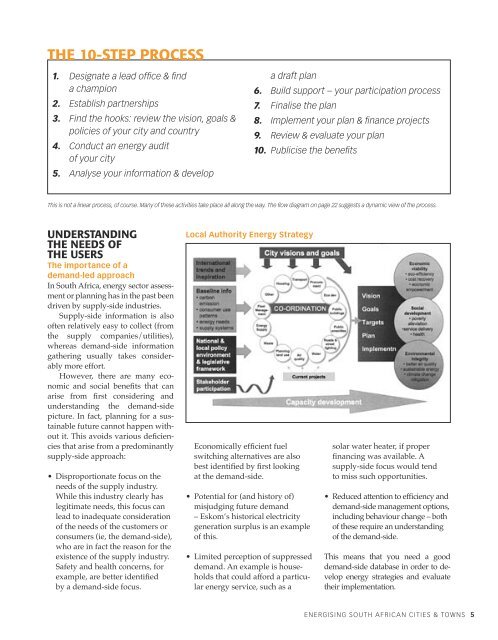Energising South African Cities & Towns - City Energy Support Unit
Energising South African Cities & Towns - City Energy Support Unit
Energising South African Cities & Towns - City Energy Support Unit
You also want an ePaper? Increase the reach of your titles
YUMPU automatically turns print PDFs into web optimized ePapers that Google loves.
THE 10-STEP PROCESS1. Designate a lead office & finda champion2. Establish partnerships3. Find the hooks: review the vision, goals &policies of your city and country4. Conduct an energy auditof your city5. Analyse your information & developa draft plan6. Build support – your participation process7. Finalise the plan8. Implement your plan & finance projects9. Review & evaluate your plan10. Publicise the benefitsThis is not a linear process, of course. Many of these activities take place all along the way. The flow diagram on page 22 suggests a dynamic view of the process.UNDERSTANDINGTHE NEEDS OFTHE USERSThe importance of ademand-led approachIn <strong>South</strong> Africa, energy sector assessmentor planning has in the past beendriven by supply-side industries.Supply-side information is alsooften relatively easy to collect (fromthe supply companies/utilities),whereas demand-side informationgathering usually takes considerablymore effort.However, there are many economicand social benefits that canarise from first considering andunderstanding the demand-sidepicture. In fact, planning for a sustainablefuture cannot happen withoutit. This avoids various deficienciesthat arise from a predominantlysupply-side approach:• Disproportionate focus on theneeds of the supply industry.While this industry clearly haslegitimate needs, this focus canlead to inadequate considerationof the needs of the customers orconsumers (ie, the demand-side),who are in fact the reason for theexistence of the supply industry.Safety and health concerns, forexample, are better identifiedby a demand-side focus.Local Authority <strong>Energy</strong> StrategyEconomically efficient fuelswitching alternatives are alsobest identified by first lookingat the demand-side.• Potential for (and history of)misjudging future demand– Eskom’s historical electricitygeneration surplus is an exampleof this.• Limited perception of suppresseddemand. An example is householdsthat could afford a particularenergy service, such as asolar water heater, if properfinancing was available. Asupply-side focus would tendto miss such opportunities.• Reduced attention to efficiency anddemand-side management options,including behaviour change – bothof these require an understandingof the demand-side.This means that you need a gooddemand-side database in order to developenergy strategies and evaluatetheir implementation.ENERGISING SOUTH AFRICAN CITIES & TOWNS 5












